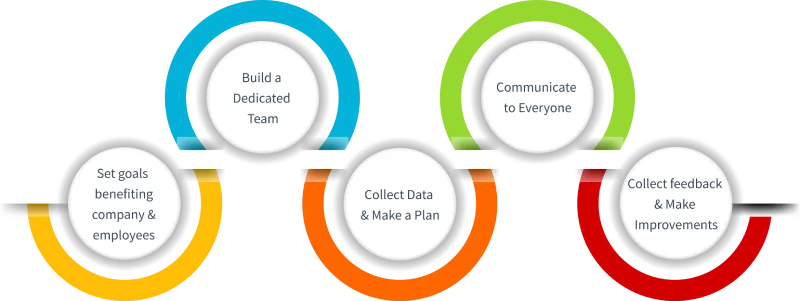Who would not like to have healthy and happy employees? Employees are the most valuable resource of any company and their health is reflected in the performance and morale of the company. Promoting wellness at the workplace also boosts the health of the employees, decreases stress, and helps in achieving a better balance between work and personal life. Let’s begin with how employee wellness programs benefit your company and workers!
What is an Employee Wellness Program?
An employee wellness program is a structured event conducted by organizations to promote and support the overall health and well-being of its employees. This typically includes programs, activities, and resources mainly focused on physical health, mental health, stress management, nutrition, and work-life balance.
Benefits of Employee Wellness Programs

1. Better Employee Health
Employee wellness programs usually
focus on long-term
behavior change. It offers a
variety of initiatives such as
activities that motivate employees
to adopt and maintain a healthy
life.
A study says 89% of
employees feel happier and
more engaged with wellness programs
conducted by their companies.
Encouraging regular exercise,
balanced diets, and frequent medical
check-ups, helps them to lead a
healthy balanced life. This also
reduces the costs of health risks.
Here are some of the main
elements of healthy behaviors:
- Balanced Nutrition
- Regular Physical Activity
- Sufficient Sleep
- Hydration
- Stress Management
- Social Connections
- Avoiding Harmful Substances
- Good Hygiene
- Preventive Healthcare
- Mental Well-being
- Personal Growth & Purpose
- Financial Well-being
Even though your employees are working from home, you can conduct virtual employee wellness programs once a week to make sure that they’re doing well. This proves that you actually care about them.
2. Greater Productivity
Healthy employees tend to be more
focused, energetic, and efficient at
work. These wellness programs easily
reduce stress and fatigue and allow
employees to stay engaged and
perform their tasks more
effectively.
It is a fact that
when employees are happy they will
be more productive at work.
Employees with good health are not
likely to be affected by issues such
as stress, loneliness, etc. However,
personal issues are inevitable, and
wellness programs assist employees
in maintaining their self-assurance
and efficiency.
3. Reduces Absenteeism
Let’s be honest! Healthy employees
are wealthy employees. Workplace
wellness programs are like secret
weapons against absenteeism.
When employees are well, they’re
less likely to get sick. Initiatives
such as Flu shots, coachings, and
stress management not only prevents
illness but also creates a healthy
work environment that keeps everyone
showing up and thriving.
But
it’s not just about flu shots,
coachings. Sometimes, heartfelt
messages such as “We care about you”
can make a positive impact in the
workplace. This actually boosts
morale, reduces absenteeism, burnout
and slashes those “I need a mental
health day” moments. The result? A
team that’s happier, healthier,
driving productivity forward.
4. High Employee Morale
When employees feel that their
company cares about them, they feel
happier and more motivated. Wellness
programs create a positive workforce
where employees feel appreciated.
When employees know that their
physical and mental health matters
to their company, they’re more
likely to enjoy their work and stay
engaged.
Good morale leads to
better
teamwork and higher
employee productivity.
Employees who feel valued usually
work harder, get along with team
members better and help to build a
friendly environment.
5. Positive Company Image
Who doesn’t love to work at a company
that prioritizes employee
well-being?
Conducting
employee well-being programs builds
a reputation and a good image in the
industry. People would love to work
in your organization. Wellness
programs make a
difference—67% of employees in such
companies feel happier at work and
are just as likely to suggest their
workplace to others. This will
definitely improve employee loyalty
and also public perception which
makes the company more attractive.
Research shows that organizations
that focus on the health of their
employees are likely to be
appreciated by the employees. This
reputation spreads through word of
mouth, employee reviews, industry
surveys, and social media.
6. Attracts Top Talent
Nowadays many companies focus on
their organization’s revenue and
profits ignoring employee’s health.
Nobody should have to sacrifice
their health to perform at their
best. Right?
Companies that
invest in employee health and
wellness are much more attractive to
top hires. Job seekers are now
actively looking beyond salaries and
considering workplace culture,
benefits, etc. Research shows that
many jobseekers prioritize these
wellness programs when evaluating
job offers, which makes it a
valuable benefit in the hiring market.
7. Strengthens Bond
Employees usually discuss their work stuff with their colleagues but with wellness programs, they’re more likely to create a deep bond. Wellness activities support teamwork and collaboration through gym fitness challenges, social activities, etc. Employees are more likely to interact on a personal level discussing their health, wealth, etc. This kind of communication can strengthen the bond and foster a sense of community within the organization.
8. Controls Chronic Diseases
Some diseases such as diabetes,
osteoporosis, depression, and high
blood pressure are not easily
diagnosed because they are
asymptomatic. These issues can be
diagnosed and addressed through
regular check-ups, counseling, etc.
Preventive measures not only help
employees to remain healthy for
longer but also reduce medical
expenses.
It is always cheaper
and easier to address health issues
before they worsen and develop
complications, especially with heart
diseases that take longer time and
resources to manage. Employers who
provide wellness programs that
target prevention can assist their
employees to remain healthy and also
reduce their medical costs.
Boost employee wellness and productivity—track, analyze, and optimize with Time Champ!
Sign up for FreeBook DemoExamples of Employee Wellness Initiatives
1. Gym Memberships and Fitness Challenges
Many employees prefer to go to the
gym rather than do physical work at
home, even though both include
physical effort. Sitting in front of
a computer for hours and hours means
nothing instead they get health
issues. So, it is important to stay
active.
Companies can help
employees by offering free or
discounted gym memberships, on-site
workout sessions, etc. For remote
employees, you can offer
virtual fitness classes as well.
Organizing fun activities such as
step challenges, calm yoga sessions,
etc. can easily keep employees
motivated.
Taking frequent
breaks in the middle of working
hours not only improves physical
health but also helps to reduce
stress and boosts mental well-being.
2. Nutrition & Wellness Plans
Encouraging healthy eating at work
can easily improve an employee’s
overall well-being. To help
employees get healthy, companies can
offer various nutritious meals,
snacks, and fresh fruits instead of
junk.
Employees should get
60-minute designated lunch breaks to
eat leisurely and build
relationships with their coworkers.
Access to dietitians, wellness
coaches, or discounts on healthy
food can also support better
lifestyle choices, leading to
improved energy and focus.
3. Smart Budgeting Workshops
Most employees struggle with managing finances. Financial stress can affect an employee’s mental health quickly. To reduce this, companies can help workers by conducting some budgeting workshops that teach simple money management skills, etc. These kinds of sessions often cover broad topics such as future savings, debts, and making smart spending choices. Some savings programs and retirement plans can also help employees secure their financial future.
4. Naps
At some point, employees feel
stressed and hectic during their
work hours. They wanted to take a
quick nap but they couldn’t. In
March 2024, Sleep Doctor conducted a
survey of 1,250 full-time employees
and discovered that 33%
admitted to sleeping during
work hours.
Short naps during
work hours can improve productivity
and energy. Some companies even have
rooms where employees can nap for
10-20 min. These powerful naps
reduce stress, fatigue, and improve
focus, and creativity. Businesses
that offer these sessions often
notice happier and healthier
employees with better work quality.
5. Mental Health Support
Companies can help employees’ mental
well-being by offering counseling,
workshops about mental health, and
stress relief activities such as
meditation, etc. Giving access to
this guidance outside the workplace
helps employees manage both personal
and professional challenges.
Creating a safe place to
discuss mental health reduces
stigma. For remote employees,
conduct one-on-one meetings and
speak about mental health issues
where it has a high chance that
employees may speak openly.
6. Community Service
Organizations should encourage
employees to engage in community
service since it will help them feel
more fulfilled. This can be done
through volunteer programs, charity
drives, or paid work time to
volunteer so that employees can make
a positive impact.
Activities
such as park cleanups, food bank
assistance, or mentorship programs
benefit the community and also
strengthen teamwork and workplace
morale. Positive impacts on the
workplace enable employees to take
pride in their professional
accomplishments.
Best Practices to Conduct an Employee Wellness Program

1. Set Goals That Benefit Both the Company and the Employees
Before starting an employee wellness program, make sure to set clear goals and objectives that align with business goals and employee well-being. Make sure that every part of the activity benefits both the employee and the company. Define your organization’s goals such as reducing absenteeism, increasing productivity, etc. At the same time, keep employees’ well-being in mind such as stress management, and physical & mental health.
2. Build a Dedicated Team
Behind every successful program, there is a dedicated team, right? It takes time and work to create a comprehensive wellness program. To handle all the issues and manage everything, you should form a good team to take care of it. Even though the team contains HR, it also needs employees who are interested in promoting a healthy life. The team should be responsible for planning, promoting, etc.
3. Collect Data & Make a Plan
Developing effective employee
wellness programs begins with
collecting data to understand their
specific needs. This can be done by
conducting surveys and analyzing
health data, such as sick leave
reports, etc. By understanding all
these data, you can create a program
that addresses mental, physical, and
emotional health. There are some
examples including fitness
challenges, mindfulness sessions,
etc.
After data collection,
the next step is to plan everything.
This includes setting clear goals
for the wellness program and
determining strategies to achieve
them. It’s also important to outline
how the program will be periodically
evaluated to ensure its
effectiveness and make necessary
adjustments over time.
4. Communicate to Everyone
Make sure to inform everyone about the wellness program. Use multiple channels such as emails, team meetings, announcement groups, etc. Make sure leadership always supports and promotes the initiatives to increase credibility. If anybody has any doubts, clarify them. Make it easy for employees to access information about wellness activities, benefits, etc.
5. Collect feedback and Make Improvements
Take regular feedback from employees about the wellness program. Use different surveys, suggestion boxes, and one-on-one meetings to get feedback. Also track key performance indicators such as participation rates, employee satisfaction, and health outcomes. Make sure to use these key data to improve the program.
Final Thoughts
In conclusion, conducting employee wellness programs can improve workplace morale and productivity , reduce absenteeism, and create a positive workplace. Prioritizing employee’s physical, mental, and financial well-being leads to a happier, healthier workforce. Companies that regularly evaluate and enhance their initiatives will establish supportive workplaces where employees flourish leading to mutual benefits for both employees and the organization.
Track attendance, analyze work patterns, and ensure employee well-being with Time Champ!
Sign up for FreeBook DemoFrequently Asked Questions
Companies can conduct virtual fitness classes, online fitness challenges, mental health webinars, etc. will keep employees healthy and active.
Yes! Wellness programs reduce employee burnout. Encouraging work-life balance, regular breaks, mental health support, and stress management can burnout.
It depends on the company’s initiatives. Companies can often see results in employee morale, productivity, and reduced absenteeism within a few months to a year.







